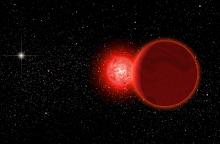Listen to today's episode of StarDate on the web the same day it airs in high-quality streaming audio without any extra ads or announcements. Choose a $8 one-month pass, or listen every day for a year for just $30.
You are here
Emptiness
It’s lonely out here in the galactic suburbs. The closest neighbors are light-years away — distances that are truly astounding. The distance to the Sun’s closest stellar neighbor, Proxima Centauri, is almost 29 million times the Sun’s diameter. At that same scale, if you lived in a house 50 feet wide, your nearest neighbor would be more than a quarter-of-a-million miles away — farther than the Moon.
That’s a pretty typical gap between star systems in this part of the galaxy — although not necessarily between individual stars. While the Sun is alone, many other stars have close companions. Proxima Centauri, for example, belongs to a system of three stars.
The space between the stars isn’t completely empty. It contains a spray of hydrogen and helium gas, plus a tiny smattering of heavier elements. On average, there’s about one atom for every cubic centimeter of space.
There’s a lot more stuff packed together in the giant clouds known as nebulae. If they have enough gas and dust, they can give birth to new stars. Even so, by earthly standards a nebula still qualifies as a hard vacuum.
The stars are all following their own orbits around the center of the galaxy, so over time, the distances between them varies. In 10,000 years, for example, Proxima Centauri will no longer be our closest neighbor. Instead, that title will belong to Barnard’s Star, at just 3.8 light-years — about half a light-year closer than Proxima Centauri is today.
Script by Damond Benningfield





